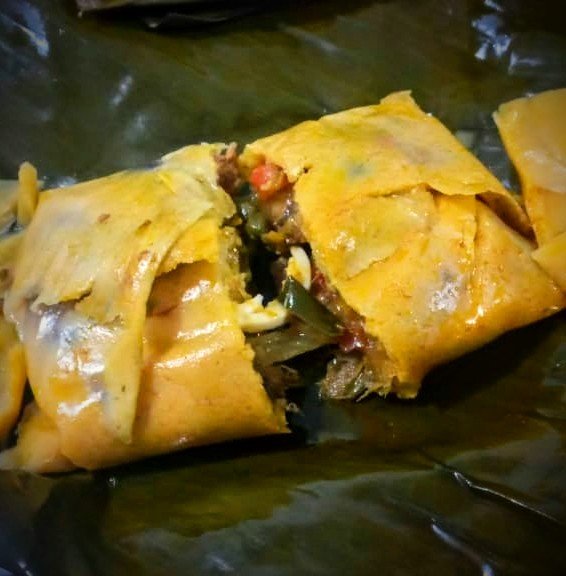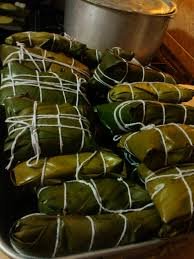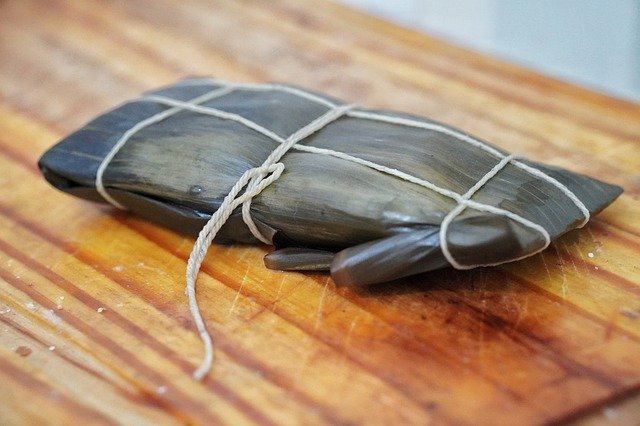
Saludos amigos, en estos momentos siendo las 3:00 p.m. hora Venezuela, se encuentra mi familia elaborando las famosas hallacas para la mesa del 31; una tía entre sus tragos que nunca falta dice: "la gente y sus cosas, quién habrá inventado la hallaca, y ahora nosotros como unos bobos, acá amarrando hojas" sonrió y surgió el debate. Esto me trajo una maravillosa idea, investigar, documentarme y lo mejor, crear este Post, que espero sea de su agrado.
Greetings friends, at this moment being 3:00 p.m. Venezuela time, my family is preparing the famous hallacas for the table of the 31st; an aunt between her drinks that is never missing says: "people and their things, who will have invented the hallaca, and now we as fools, here tying leaves" smiled and the debate arose. This brought me a wonderful idea, to investigate, document myself and the best, create this Post, which I hope you will like.

CONCEPTUALIZANDO UN POCO
CONCEPTUALIZING A LITTLE.
La hallaca, es un plato envuelto que consiste en un pastel hecho con masa de maíz, saborizada con caldo de gallina y coloreada con onoto, relleno con un guiso de carne de res, cerdo y gallina o pollo (aunque hay versiones que llevan pescado), al cual se le agregan aceitunas, uvas pasas, almendras, alcaparras, pimentón y cebolla, envuelto de forma rectangular en hojas de plátano o de bijao (palma semejante a la del plátano, aunque de textura más fuerte), para finalmente ser atada con pabilo o pita y hervida en agua.
The hallaca is a wrapped dish consisting of a cake made with corn dough, flavored with chicken broth and colored with onoto, filled with a stew of beef, pork and chicken or chicken (although there are versions with fish), to which are added olives, raisins, almonds, capers, paprika and onion, wrapped in a rectangular shape in banana or bijao leaves, raisins, almonds, capers, paprika and onion, wrapped in a rectangular shape in banana or bijao leaves (a palm similar to the banana, but with a stronger texture), and finally tied with wicker or pita and boiled in water.


Es un plato que, a pesar de que se puede servir en cualquier momento del año, es típico de la temporada navideña. En Venezuela, es uno de los platos nacionales, guardando cierta semejanza en forma y preparación con los tamales de otros países americanos; en nuestra nación, se lleva a cabo la preparación de este plato navideño siempre en familia, llegando a ser utilizado como una excusa para celebrar y compartir entre amigos y familiares.

It is a dish that, although it can be served at any time of the year, it is typical of the Christmas season. In Venezuela, it is one of the national dishes, keeping certain similarity in form and preparation with tamales from other American countries; in our nation, the preparation of this Christmas dish is always carried out in family, being used as an excuse to celebrate and share among friends and family.

UN TANTICO DE HISTORIA
A LITTLE BIT OF HISTORY.
Una historia de la cultura fantasiosa venezolana cuenta que el nombre de la hallaca proviene de la combinación de dos palabras: Allá (refiriéndose a los componentes del guiso que provienen de otros países) y Acá (refiriéndose a la masa y las hojas de plátano) donde como resultado Allá y acá, combinando y mejorando la palabra este plato recibiría el nombre de Hallaca. Hay quienes relacionan la hallaca con el ayacá de las lenguas tupí-guaraní, que significa bulto, lío y últimamente cesta en el idioma guaraní suroccidental.
A history of Venezuelan fantasy culture tells that the name of the hallaca comes from the combination of two words: Allá (referring to the components of the stew that come from other countries) and Acá (referring to the dough and banana leaves) where as a result Allá and acá, combining and improving the word this dish would receive the name of Hallaca. There are those who relate the hallaca with the ayacá of the Tupi-Guarani languages, which means bundle, mess and lately basket in the southwestern Guarani language.


El origen del plato se remonta a los años de la colonización por parte de España, siglo XV y siglo XVI, atribuyéndose en forma legendaria su invención a los esclavos y sirvientes indígenas, quienes recogían los restos de las preparaciones de sus opresores para armar un plato heterogéneo que les sirviese de alimento extra a sus comidas habituales. Más probable es, que éste mismo plato típico de Venezuela y Colombia provino de los esfuerzos que tomaron los españoles en «mejorar» el tamal, entre otros platos precolombinos, expandiendo los ingredientes que componían el relleno. Tales esfuerzos representaron una adaptación colonial al paladar europeo del español en América.

The origin of the dish dates back to the years of colonization by Spain in the 15th and 16th centuries, its invention being legendarily attributed to the indigenous slaves and servants, who collected the remains of their oppressors' preparations to assemble a heterogeneous dish that would serve as extra food to their usual meals. More likely, this same typical dish of Venezuela and Colombia came from the efforts of the Spaniards to "improve" the tamale, among other pre-Columbian dishes, by expanding the ingredients that made up the filling. Such efforts represented a colonial adaptation to the European palate of the Spanish in America.

Existe también una tradición que indica que cuando se estaba construyendo el «Camino de los españoles» (vía que comunicaba el Puerto de La Guaira con Caracas), por parte de los indios, principalmente, estos consumían generalmente unos «bollos» o tamales, básicamente de puro maíz, y ahora es sabido que el consumo de solo maíz, produce una enfermedad por avitaminosis, que se llama pelagra, y se producía las enfermedades en dicha población. Por esa causa, se les pidió a las familias caraqueñas que donaran sus sobrantes de las comidas para que los indios los pusieran en sus «bollos», como lo hacían con sus esclavos y siervos.
There is also a tradition that indicates that when the "Camino de los Españoles" (road that communicated the Port of La Guaira with Caracas) was being built, mainly by the Indians, they generally consumed "bollos" or tamales, basically of pure corn, and it is now known that the consumption of only corn, produces a disease by avitaminosis, which is called pellagra, and produced diseases in that population. For this reason, Caracas families were asked to donate their leftover food for the Indians to put in their "bollos", as they did with their slaves and servants.


Cuenta la tradición que en unas Navidades, que los criollos acostumbraban a celebrar con gran pompa y comilonas de todo tipo, el obispo de Caracas enfurecido por estas costumbres, les exhortó a comer como los indios que trabajaban en el «Camino de los Españoles», con hallacas o bollos o tamales rellenos de sobras. Por supuesto, esos criollos temerosos de Dios así lo adoptaron, pero con sus propias recetas de la hallaca, cada cual más gustosa. La hallaca constituye un ejemplo interesante de las consecuencias del mestizaje y sus manifestaciones de carácter universal, tal como lo dijo Arturo Uslar Pietri: “…es como un compendio ejemplar del proceso de mestizaje. En ella están: la pasa y la aceituna de romanos y griegos, la alcaparra y la almendra de los árabes, la carne del ganado de los capitanes pobladores de Castilla, el maíz y la hoja del bananero de los indios”.

Tradition has it that on Christmas, which the Creoles used to celebrate with great pomp and feasts of all kinds, the bishop of Caracas, infuriated by these customs, urged them to eat like the Indians who worked on the "Camino de los Españoles", with hallacas or buns or tamales filled with leftovers. Of course, these God-fearing Creoles adopted it, but with their own hallaca recipes, each one more tasty than the last. The hallaca is an interesting example of the consequences of miscegenation and its universal manifestations, as Arturo Uslar Pietri said: "...it is like an exemplary compendium of the process of miscegenation. In it are: the raisin and the olive of the Romans and Greeks, the caper and the almond of the Arabs, the meat of the cattle of the settler captains of Castile, the corn and the banana leaf of the Indians".

HALLACA Y NAVIDAD
HALLACA AND CHRISTMAS
Es tiempo de compartir lo que se ha vivido y de renovar las esperanzas del porvenir incierto. Comemos hallaca, suena la gaita, viva la fiesta de vivir, se celebra el momento del encuentro, de la amistad, del amor. El cuerpo abandona la tristeza y la soledad y se vuelca, entusiasmado, a la corriente de la vida solidaria que invita a la celebración festiva. La mesa familiar está servida. La preside la hallaca, la reina de la fiesta navideña venezolana. Pero no siempre fue así. De comida ordinaria, que se sirve en cualquier época del año sin notables gestos celebratorios, la hallaca, por su compleja elaboración y la suculencia de su contenido, fue convirtiéndose en una comida extraordinaria, inmersa en el ritual decembrino de las celebraciones religiosas, y terminó por ser la reina de la fiesta y de la mesa urbana.
It is time to share what has been lived and to renew the hopes of the uncertain future. We eat hallaca, the gaita sounds, long live the party of living, the moment of encounter, friendship and love is celebrated. The body abandons sadness and loneliness and turns, enthusiastic, to the current of life in solidarity that invites to the festive celebration. The family table is served. The hallaca, the queen of the Venezuelan Christmas feast, presides over it. But it was not always like that. From an ordinary food, served at any time of the year without notable celebratory gestures, the hallaca, due to its complex elaboration and the succulence of its contents, gradually became an extraordinary food, immersed in the Christmas ritual of religious celebrations, and ended up being the queen of the party and of the urban table.


Esa conversión de plato servido de manera ordinaria en cualquier época del año, a plato central de la Navidad venezolana, se debe a varias razones. La primera es que en el tránsito de la Venezuela rural a la Venezuela urbana ocurrieron importantes cambios. El que más, la incorporación notable y progresiva de la mujer al mercado de trabajo y al sistema educativo, lo que redujo el tiempo de su permanencia en el hogar e hizo que las labores domésticas más pesadas fueran sustituidas por otras que representaran un menor tiempo de ejecución. La hallaca, de demorada confección, dejó de elaborarse de manera frecuente para ser hecha en épocas especiales como la Navidad.

This conversion from an ordinary dish served at any time of the year to the central dish of Venezuelan Christmas is due to several reasons. The first is that in the transition from rural Venezuela to urban Venezuela, important changes took place. The most important was the notable and progressive incorporation of women into the labor market and the educational system, which reduced the time they spent at home and meant that the heaviest domestic chores were replaced by others that took less time to perform. The hallaca, which took a long time to make, was no longer made frequently, but only at special times such as Christmas.

La segunda razón es que en la sociedad venezolana se fue instalando, lenta y progresivamente, la costumbre de la celebración de la Navidad y, en especial, de la Nochebuena, como un acto público más que una actividad privada, tal como lo había sido hasta finales del siglo XIX. En la Venezuela rural las reuniones familiares se desarrollaban más en el ámbito privado que en el público. Había menores ocasiones para una intensa interacción social, reducida por lo general a las celebraciones familiares.
The second reason is that Venezuelan society slowly and progressively installed the custom of celebrating Christmas, and especially Christmas Eve, as a public act rather than a private activity, as it had been until the end of the 19th century. In rural Venezuela, family gatherings were more private than public. There were fewer occasions for intense social interaction, usually reduced to family celebrations.


La hallaca se volvió la reina de la mesa navideña, acoplándose al espíritu festivo de la Navidad, porque se trata de una comida ceremonial que invita al consumo colectivo o en común del grupo, y que es de elaboración compartida por los miembros de la familia. Se convirtió en el centro de la sociabilidad navideña, porque al comer y beber juntos se produce un ritual de unión o de agregación, que invita a la fiesta grupal. Y de confección alimentaria, se volvió un fuerte lazo espiritual entre los venezolanos.

The hallaca became the queen of the Christmas table, fitting in with the festive spirit of Christmas, because it is a ceremonial meal that invites collective or common consumption of the group, and that is of shared elaboration by the members of the family. It became the center of Christmas sociability, because eating and drinking together produces a ritual of union or aggregation, which invites to the group celebration. And from food confection, it became a strong spiritual bond among Venezuelans.

Dada su riqueza simbólica, es ahora el centro de una compleja trama de relaciones en el ámbito nacional de lo social, de clara lectura polisémica. La hallaca es el signo del reencuentro familiar anual, referencia de la celebración navideña asociada a lo religioso y camino que nos conduce a la patria nutricia y al regazo primero de la madre ya muerta, que reencarna cada año, convidada por las delicias del guiso que alienta el espíritu supremo de la hallaca.
Given its symbolic richness, it is now the center of a complex web of relationships in the national social sphere, with a clear polysemic reading. The hallaca is the sign of the annual family reunion, reference of the Christmas celebration associated to the religious and the path that leads us to the nourishing homeland and to the first lap of the mother already dead, who reincarnates every year, invited by the delights of the stew that encourages the supreme spirit of the hallaca.

√ HALLACA
√ LA VERDADERA HISTORIA DE LA HALLACA





The rewards earned on this comment will go directly to the person sharing the post on Twitter as long as they are registered with @poshtoken. Sign up at https://hiveposh.com.
Una de las mejores cosas de la navidad, muy buenas referencias históricas y excelente maquetado! un post de calidad, saludos y bendiciones, feliz día.
muchas gracias... sin lugar a dudas la hallaca es la comida que une corazones, bendiciones...
Esa hallaca se ve deliciosa, muy informativo y útil tu post. Fue grato leerte. Saludos.
hola. gracias por leer mi Post, esa hallaca la hace mi mama creó que es la mejor del mundo JEJEJE saludos un abrazo
Mejor forma para explicar a profundidad lo que es una hallaca no hay, muy buena tu publicación 😉👍🏻
hola muchas gracias, un placer para mí saber que les agradó mi escrito... saludos
Esta muy bueno el post, me gusto mucho la información que nos comparto de porque el nombre de Hallaca, la verdad no la sabía. Muy buen trabajo, saludos!
hola muchas gracias. un placer haber hecho un buen aporte a todos...
Muy buen trabajo de investigación y de sistematización informativa, muy amena además, acerca del origen e historia de la hallaca, nuestro plato navideño por excelencia. Saludos, @krrizjos18.
saludos muchas gracias amigo... feliz navidad
Maravillosa reseña, que lindas tradiciones nos simbolizan, me encantó el origen del nombre: "Allá" y "Acá". ¡¡Saludos!!
JEJEJE si allá y acá ni yo sabia eso JEJEJE abrazos...
Se ve deliciosa y el nombre me llamó mucho la atención, saludos
esa la hizo mi mama JEJEJE gracias x pasar x acá
Me parece interesantísimo lo que cuentas acerca del origen del nombre, ya yo sabía el origen como tal de la hallaca, que venía de las sobras, pero hoy aprendí lo del nombre, me parece bastante apropiado. Muchas gracias por brindarnos esta información.
hola mil gracias a tí por tu buen comentario... un abrazo
Me encanto toda la información acerca de la hallacas, es muy importante saber los origines de las tradiciones. Gracias por compartir.Saludos!!
siempre a la orden... un abrazo